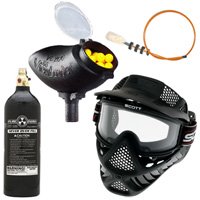 12g - 12 gram CO2 cartridges: powered the early paintball guns.
12g - 12 gram CO2 cartridges: powered the early paintball guns. APG - Action Pursuit Games--a paintball magazine
Anti-Siphon - A special CO2 tank designed to reduce the likelihood of liquid going into the gun.
Barrel condom - A bag that fits over the business end of the marker's muzzle. It prevents projectiles from accidentally leaving the gun.
Bottom Line - Usually refers to the local of the CO2 tank on the bottom rear portion of the marker's pistol grip. Desired since it makes sitting the gun with a mask on much easier.
Bunker (noun) - An object or embankment on the field that a player uses for cover.
Bunker (verb) - To charge a bunker and eliminate (hopefully), at close range, any players hiding behind it.
CA - Constant Air--allows marker to use bulk CO2 tanks rather than 12 gram.
Chronograph - A device used to measure the velocity (speed) of a paintball coming out of a barrel. The safe maximum speed of a paintball is 300 feet per second.
CO2 - Carbon Dioxide--compressed gas used to power paintball guns.
Hopper - A larger hopper which holds paintballs - feeding them into the gun through its bottom, typically holds around 200 rounds.
Hopper Agitator - An electronic device which is located at the base of the feeder. The agitator helps insure that balls feed through the bottom of the feeder. Often used on faster firing guns like the Intimidator, AutoMag, AutoCocker, Shocker, Angel, and many other higher end paintball guns.
FPS - Feet Per Second. The measurement of speed at which the paintball travels. 300 fps is the maximum velocity a paintball may travel safely Recreation play is typically around 270 fps.
Harness or Ammo Pack - Belt/harness system for carrying tubes of paint so a player may reload their hopper on the field during play.
HPA - Compressed Air High-pressure compressed air (3000 to 4500 psi) is usually used instead of CO2 in tournament paintball. The use of HPA requires specialized high pressure tanks and regulators, which lower the output pressure to what paintball guns need.
PSI - stands for Pounds Per Square Inch and is a measurement of pressure in the air tanks.
Remote Hoses and fittings which allow the air tank to be detached from the manufacture's intended location on the gun, then located elsewhere (e.g. on the player's pack).
Siphon Bottle - A special CO2 tank designed to avoid liquid going into the paintball gun.
Speedball - Speedball is a game played on small fields with little natural cover. Bunkers usually consist of wooden pallets, tires or other man-made barricades. Speedball fields are designed to allow spectators to see the action. The first speedball field was set up at SC Village in Corona, CA.
Squeegee - A device used to clean paint from the barrel of a paintball gun, either a pull-through or straight with many types of material used.


